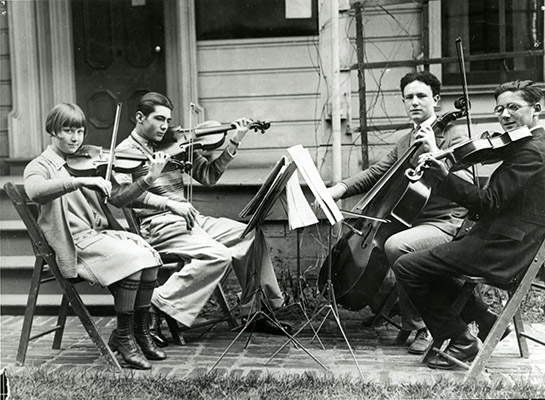In our scrapbook collection we have a typewritten program of 1923 performances at the San Francisco Public Library for the City of San Francisco 3rd Annual Music Week. This event was co-sponsored by the University of California Extension Division.
The Community Music Center (then called the Community Music School Settlement) performed on the morning of November 3, 1923. The two student conductors, Preston Hartman and Alfred Bousquet, were members of the 1926 string quartet.
An Oakland Tribune reviewer attending the convention of the California Federation of Music Clubs in 1924 took special notice of this orchestra . He described them as
a determined group of young fiddlers who we delighted to hear not alone for the good sort of music they offered but for the infection delight they took in offering it. Then there was one little shaver, Preston Hartman by name, who stood right out in front and led his mates with as magnificent an air as ever John Phillip Sousa could have mustered.Preston Hartman was very active with the Community Music School. At age 12 he had written an arrangement of the lullaby "Sleep, Baby, Sleep" for his fellow students to play.

source: San Francisco Examiner January 3, 1926
A 1926 article tells of Jeanette Davis and Preston Hartman meeting with San Francisco Symphony conductor Alfred Hertz who gave them conducting tips. According to their yearbook, The Red and White, Preston Hartman led Lowell High School's string quartet in 1927.
Preston Hartman - source The Red and White [yearbook], December 1927.
After graduating he went to work as a clerk at the Anglo-California National Bank, but he remained an amateur musician throughout his life. According to his 2005 obituary he performed with the Shrine Band. A 1938 article mentioned that he was a member of the Berkeley Violin Club orchestra. He also performed in the Marin Symphony Orchestra. He also was a member of the orchestra for The Family, an all-male social club.
The published script of the 1946 Family Flight play of 1946 shows Preston Hartman as a member of The Everfaithful, the orchestra that accompanied the club's performances. Here he performed alongside San Francisco Symphony musicians like Caeser Addimando, Fred A. Baker, Julius Haug, Ernest Kubitschek, Merrill L. Remington, Robert Rourke, Leslie Jerome Schivo, Rudy Seiger, Rogers F. Shoemaker, and Erich Weiler
source: San Francisco Chronicle (February 15, 2006).
Preston Hartman was born February 25, 1911 and died November 8, 2005.
Alfred Bousquet - source: The Mission [yearbook] Fall 1927
Alfred Bousquet was a musical standout at Mission High School. He played in the all-state orchestra. He also represented his school in the National Orchestra at the Superintendent's Conference in Dallas, Texas in February 1927. According to the 1940 census he completed 3 years of college. He then worked as a teller at Bank of America. Alfred Bousquet was born March 4, 1911 and died January 19, 1981.
The fourth member of the Community Music School String Quartet, Emmet Peterson, went on to attend and graduate from St. Mary's College in 1931. In 1940 he became a civil law clerk for the Municipal Court.
Peterson remained active with the Community Music School / Center throughout his life. According to a 1968 memorial article in the Minute Book, a publication of the Association of Municipal Court Clerks of California, he was active with the school for 50 years. He later joined the school's board and served as treasurer. During the 1950s he was involved with the arrangements committee for the school's rummage sales.
source: San Francisco Chronicle (February 22, 1959)
His obituary in the April 17, 1965 Chronicle described him as "one of the most admired and beloved figures in City Hall." The Community Music Center honored him by presenting a black pine tree to the Strybing Arboretum with a plaque in Peterson's honor. Emmet J. Peterson was born December 18, 1911 and died April 15, 1965.
source: San Francisco Chronicle (April 28, 1966)
None of the members of the Community Music School's String Quartet of 1926 went on to achieve fame as musicians. But they all assumed role as hidden musical citizens within the wider musical life of San Francisco.
"Berkeley Violin club to give annual concert," Berkeley Daily Gazette (March 23, 1938).
"Children to give concert today," San Francisco Chronicle (June 1, 1923).
Danforth, Roy Harrison, "New themes fill delegates time, "Oakland Tribune April 30, 1924.
"Emmet Peterson," San Francisco Chronicle (April 17, 1965).
The Mission (Associated Students of the Mission High School, Spring; Fall 1927).
"Music school plans annual rummage sale," San Francisco Chronicle (April 4, 1952).
"New relief from 'atticolitis'," San Francisco Chronicle (January 29, 1956).
"Ninety will be graduated from St. Mary's College," San Francisco Chronicle (May 19, 1931).
"Out of the past, ten years ago today," San Rafael Daily Independent Journal (January 24, 1951).
"Pine tree to be presented to Arboretum," San Francisco Chronicle (April 28, 1926).
"Preston Hartman," San Francisco Chronicle (February 15, 2006).
So We Built a Church for "Steve"; Being the story of the building of the Chapel of Our Lady of the Wayside / the book by Richard Prosser; the music by Charles Runyan; general direction of Vincent E. Duffey. Based on a paper read at the Flight of 1943 by Harald Pracht; presented by the players and musicians of the Family, in the Valley of Portola on Sunday evening, September 1, 1946. The flight play for 1946 (The Family, 1947).
The Red and White (Lowell High School Students Association, December 1927).
"Rummage sale set for April 1 and 2," San Francisco Chronicle (January 30, 1953).
San Francisco Programs. Music (San Francisco Public Library, 1923).
"Two civil service posts awarded," San Francisco Chronicle (February 29, 1940).






















































